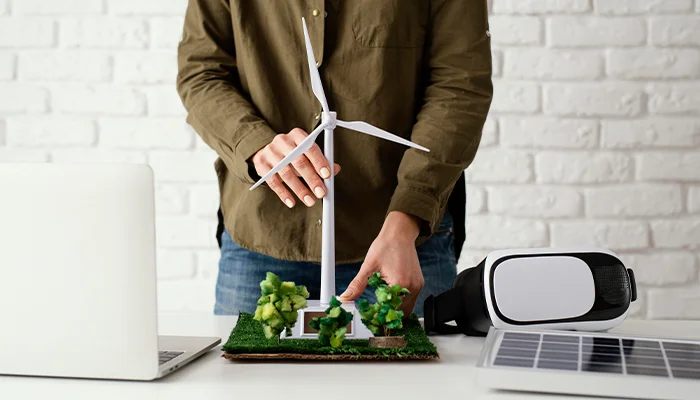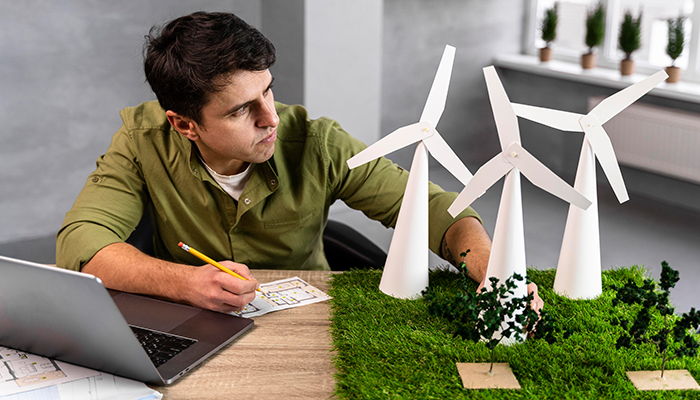Impact of IoT on Renewable Energy Sources

MAY, 22, 2024 14:30 PM
Impact of IoT on Renewable Energy Sources
The advent of Internet of Things (IoT) technology has ushered in a new era of connectivity and intelligence in various industries, including renewable energy. The integration of IoT in renewable energy sourcessuch as solar, wind, and hydropower systems has revolutionized the way these sources are harnessed, managed, and optimized. This comprehensive essay delves into the multifaceted impact of IoT on renewable energy sources, exploring how IoT technologyenhances efficiency, reliability, and sustainability in the renewable energy sector.
IoT in Renewable Energy Sources
Solar Energy
Solar energy systems, particularly photovoltaic (PV) panels, are increasingly integrating IoT technology to enhance their efficiency and output. IoT devices in solar energy systems monitor various parameters, such as sunlight intensity, panel temperature, and energy output. These devices provide real-time data to optimize the angle of solar panels, predict maintenance needs, and manage energy storage systems.
- Real-Time Monitoring and Optimization: IoT-enabled sensors and smart inverters continuously monitor the performance of solar panels. By analyzing data such as solar irradiance and panel efficiency, IoT systems can adjust the orientation of solar panels to maximize energy absorption. This dynamic optimization ensures that solar panels operate at peak efficiency throughout the day, even under varying weather conditions.
- Predictive Maintenance: IoT technologyenables predictive maintenance by monitoring the health and performance of solar panels. Sensors detect anomalies such as dirt accumulation, shading, or potential hardware failures. By predicting and addressing these issues before they lead to significant energy losses, IoT technologyminimizes downtime and maintenance costs, ensuring continuous and reliable energy production.
- Energy Management Systems: IoT-based energy management systems (EMS) play a crucial role in balancing energy production and consumption. These systems analyze data from solar panels, energy storage units, and household or industrial energy usage. By coordinating energy flow, IoT-enabled EMS can optimize energy storage, reduce waste, and ensure a stable supply of renewable energy.
Wind Energy
Wind energy, harnessed through wind turbines, benefits significantly from IoT technology.The integration of IoT in wind energy systems improves the efficiency, reliability, and safety of wind turbines.
- Performance Monitoring: IoT sensors installed on wind turbines monitor critical parameters such as wind speed, turbine rotation speed, vibration levels, and power output. This data is transmitted in real-time to centralized control systems, enabling operators to monitor the performance of each turbine and make adjustments to optimize energy generation.
- Predictive Maintenance and Fault Detection: Similar to solar energy systems, IoT technologyfacilitates predictive maintenance for wind turbines. Sensors detect early signs of wear and tear, lubrication needs, or mechanical faults. By addressing these issues proactively, operators can prevent unexpected breakdowns and extend the lifespan of wind turbines.
- Weather Forecasting and Adaptation: IoT devices, combined with advanced weather forecasting models, provide accurate predictions of wind patterns and weather conditions. This information helps in adjusting the operational parameters of wind turbines to maximize energy capture during high wind periods and protect the turbines during extreme weather events.
Hydro Energy
Hydro energy, derived from water flow in rivers, dams, or ocean tides, also leverages IoT technologyto enhance efficiency and sustainability.
- Flow and Level Monitoring: IoT sensors monitor water flow rates, water levels in reservoirs, and turbine performance in real time. This data enables operators to manage water resources more effectively, optimizing the flow to maximize energy production while ensuring the sustainability of the water source.
- Predictive Maintenance: IoT technologyin hydroenergy systems provides predictive maintenance capabilities by monitoring the condition of turbines, generators, and other critical components. Early detection of potential issues, such as corrosion or mechanical wear, allows for timely maintenance, reducing downtime and maintenance costs.
- Environmental Monitoring: IoT devices play a crucial role in monitoring the environmental impact of hydroenergy projects. Sensors track water quality, fish migration patterns, and other ecological parameters. This data helps minimize the environmental footprint of hydroenergy projects and ensure compliance with environmental regulations.
Benefits of IoT in Renewable Energy Sources
Enhanced Efficiency and Performance
One of the primary benefits of IoT in renewable energy sourcesis the enhancement of efficiency and performance. By providing real-time data and insights, IoT technologyenables operators to optimize the operation of renewable energy systems, ensuring they produce the maximum amount of energy possible. For instance, IoT-enabled solar panels can adjust their orientation based on sunlight intensity, while wind turbines can adapt to changing wind conditions.
Reduced Operational Costs
IoT technologysignificantly reduces operational costs associated with renewable energy systems. Predictive maintenance, facilitated by IoT sensors, minimizes unplanned downtime and reduces the frequency of major repairs. Real-time monitoring also allows for more efficient use of resources, such as water in hydro energy systems or the tilt mechanism in solar panels, leading to cost savings.
Improved reliability and stability
The integration of IoT into renewable energy sourcesimproves the reliability and stability of energy production. IoT devices monitor the health and performance of critical components, ensuring that potential issues are detected and addressed before they cause significant disruptions. This proactive approach enhances the overall stability and reliability of renewable energy systems, making them more dependable sources of energy.
Data-Driven Decision Making
IoT technology enables data-driven decision-making in the renewable energy sector. The vast amount of data collected by IoT devices provides valuable insights into the performance, efficiency, and health of renewable energy systems. This data-driven approach allows operators to make informed decisions, optimize operations, and plan for future expansions or upgrades.
Environmental Sustainability
IoT technology contributes to environmental sustainability by optimizing the use of renewable energy sources and minimizing their environmental impact. For example, IoT-enabled hydroenergy systems can manage water resources more efficiently, ensuring that water levels in reservoirs are maintained at sustainable levels. Similarly, IoT devices can monitor and mitigate the environmental impact of renewable energy projects, such as the effect of wind turbines on bird populations or the impact of hydroelectric dams on fish migration.
Challenges and Considerations

Data security and privacy
The widespread use of IoT devices in renewable energy systems raises concerns about data security and privacy. The data collected by IoT sensors is valuable, but it is also vulnerable to cyberattacks and unauthorized access. Ensuring the security and privacy of this data is crucial to maintaining the integrity and reliability of renewable energy systems.
Interoperability and standardization
The renewable energy sector encompasses a wide range of technologies and systems, each with its own set of IoT devices and protocols. Ensuring interoperability and standardization across these diverse systems is a significant challenge. Developing common standards and protocols for IoT devices in renewable energy systems is essential for seamless integration and effective data exchange.
Initial investment and deployment
The initial investment required for deploying IoT technology in renewable energy systems can be substantial. The cost of IoT sensors, communication infrastructure, and data analytics platforms can be a barrier for some renewable energy projects. However, the long-term benefits in terms of efficiency, cost savings, and reliability often outweigh the initial investment.
Data management and analytics
The vast amount of data generated by IoT devices in renewable energy systems presents a challenge in terms of data management and analytics. Storing, processing, and analyzing this data requires advanced data analytics tools and expertise. Developing robust data management and analytics capabilities is essential for harnessing the full potential of IoT technologyin renewable energy.
Conclusion
The impact of the IoT on renewable energy sources is profound and transformative. By enabling real-time monitoring, predictive maintenance, and data-driven decision-making, IoT technology enhances the efficiency, reliability, and sustainability of renewable energy systems. The integration of IoT in solar, wind, and hydro energy systems optimizes energy production, reduces operational costs, and improves the overall stability of these renewable sources.
Despite the challenges associated with data security, interoperability, and initial investment, the long-term benefits of IoT technologyin the renewable energy sector are undeniable. IoT app development companies play a crucial role in facilitating this integration, providing customized solutions, advanced data analytics, and ongoing support.
Looking ahead, innovations such as AI, blockchain, edge computing, and enhanced connectivity will further amplify the impact of IoT on renewable energy sources. As these technologies continue to evolve, they will unlock new opportunities for optimizing and expanding the use of renewable energy, contributing to a more sustainable and resilient energy future.
FAQs on the Impact of IoT on Renewable Energy Sources
Q1. How does IoT technology improve the efficiency of renewable energy sources?
A1. IoT technology enhances the efficiency of renewable energy sources by enabling real-time monitoring and optimization. In solar energy systems, IoT sensors can adjust the orientation of solar panels to maximize sunlight absorption based on current weather conditions. For wind turbines IoT devices monitor wind speed and turbine performance, allowing for adjustments to optimize energy capture. In hydroenergy systems, IoT sensors manage water flow and turbine performance to ensure maximum energy production. Additionally, predictive maintenance facilitated by the IoT reduces downtime and operational costs, further improving overall efficiency.
Q2. What role do IoT app development companies play in integrating IoT with renewable energy sources?
A2. IoT app development companies are crucial in integrating IoT technologywith renewable energy sources. They provide customized IoT solutions tailored to specific renewable energy projects, including ;specialized sensors, data analytics platforms, and user interfaces for effective monitoring and control. These companies handle the end-to-end integration and deployment of IoT devices, ensuring seamless incorporation into existing systems. They also offer advanced data analytics capabilities to derive actionable insights from collected data and provide ongoing maintenance and support to ensure the smooth and efficient operation of IoT-enabled renewable energy systems.




Strategy
Design
Blockchain Solution
Development
Launching
Testing
Maintenance
Contact US!
India

Plot 378-379, Udyog Vihar Phase 4 Rd, near nokia building, Electronic City, Phase IV, Sector 19, Gurugram, Haryana 122015
Copyright © 2025 PerfectionGeeks Technologies | All Rights Reserved | Policy
Strategy
Design
Blockchain Solution
Development
Contact US!
India 
Plot 378-379, Udyog Vihar Phase 4 Rd, near nokia building, Electronic City, Phase IV, Sector 19, Gurugram, Haryana 122015
USA 
1968 S. Coast Hwy, Laguna Beach, CA 92651, United States
Copyright © 2025 PerfectionGeeks Technologies | All Rights Reserved | Policy


